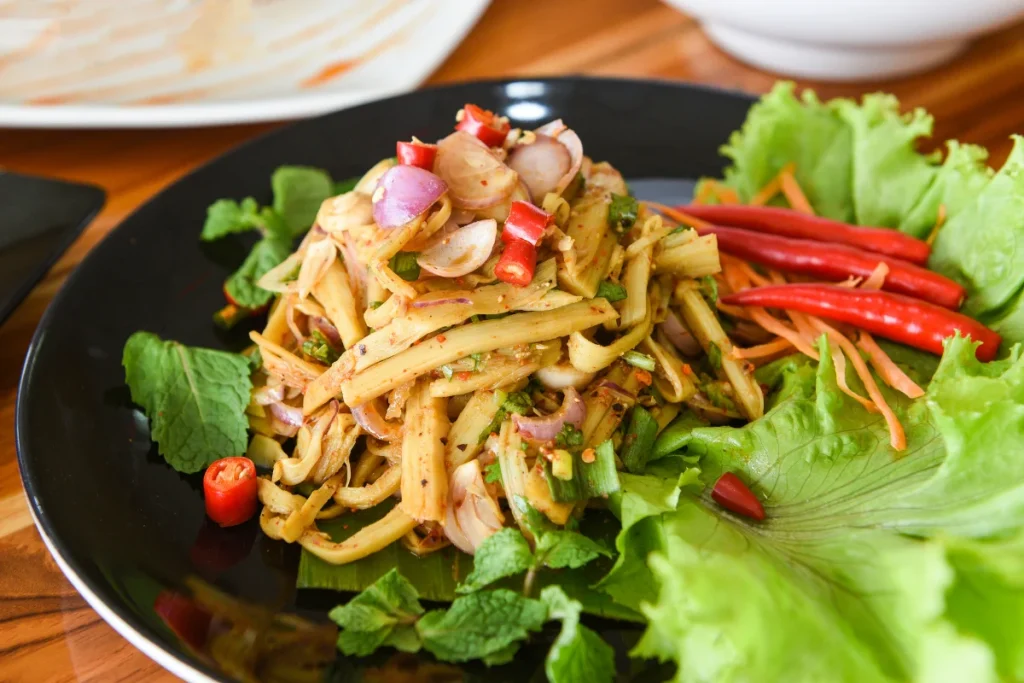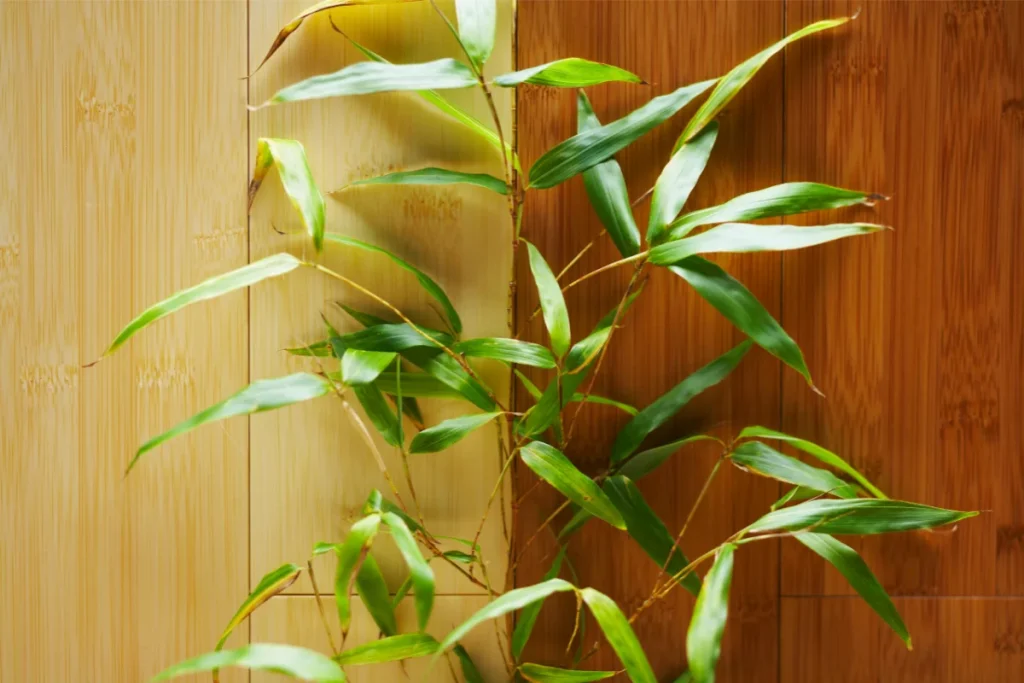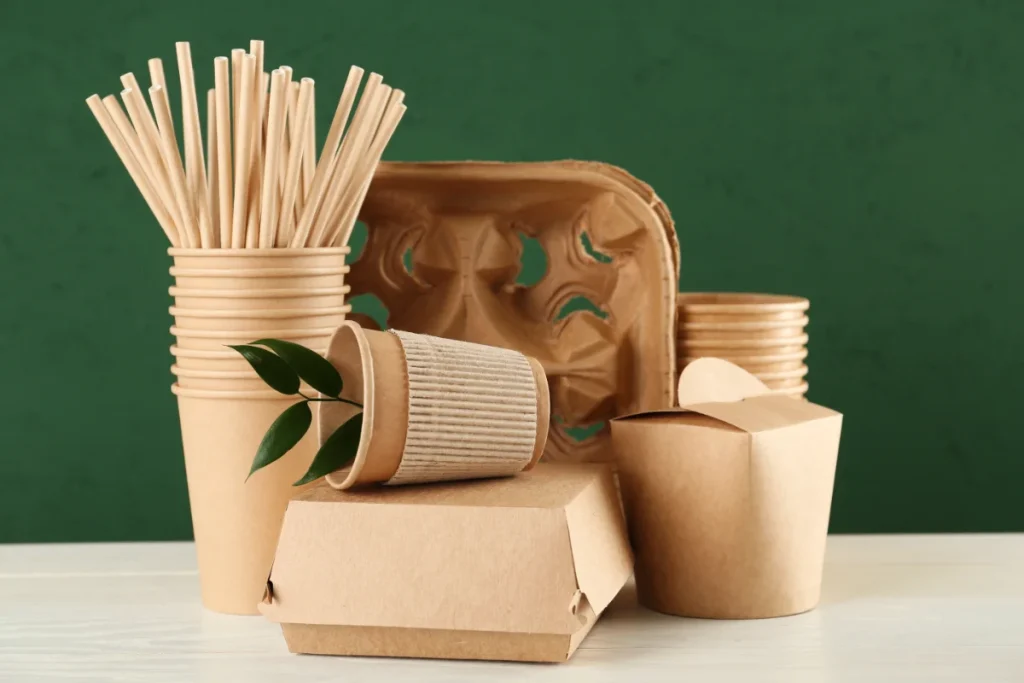
Bamboo Arts and Crafts: Exploring Nature’s Creative Canvas
Introduction:
Bamboo, a versatile and sustainable material, serves as a natural canvas for artisans and craftsmen worldwide. In the realm of art and craft, this resilient grass emerges as a unique medium, offering artists and artisans a palette that blends nature’s elegance with human ingenuity. From intricate basketry to contemporary sculptures, bamboo art and craft showcase the marriage of traditional techniques with modern creativity.
This rich and diverse world of artistic exploration unveils the boundless possibilities that bamboo affords, weaving together tradition, innovation, and environmental consciousness into exquisite masterpieces.
Bamboo: A Natural Wonder
Bamboo, often misconstrued as a tree, is a rapidly growing grass that proliferates across various continents, thriving in diverse climates. Its sturdy and pliable nature makes it an ideal material for a wide array of artistic expressions and functional creations.
Where is Bamboo Found?
Bamboo’s natural habitat spans Asia, the Americas, Africa, and parts of Europe, adapting to climates from tropical to temperate zones. This ubiquity contributes to its prominence in diverse cultural art forms and daily utility.
Why is Bamboo Used for Arts and Crafts?
The unique characteristics of bamboo, including its strength, flexibility, and sustainable growth patterns, render it an exemplary choice for artists and craftsmen. Its eco-friendliness aligns with the current global emphasis on sustainable materials, making it an ideal medium for artistic expression and functional creations.
Types of Bamboo Arts and Crafts
Bamboo, with its pliable nature and versatility, lends itself to various forms of artistic expression and craftsmanship. Let’s explore the diverse manifestations of bamboo in the creative world:
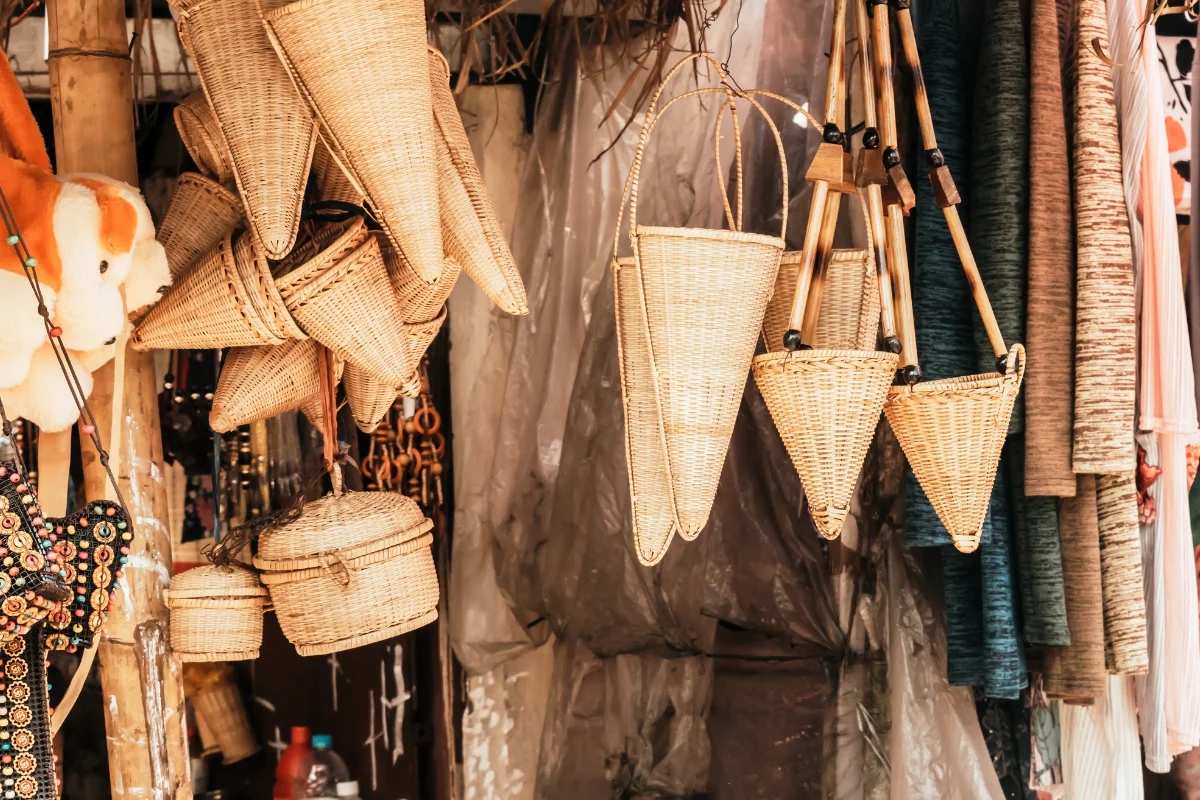
Bamboo Painting:
Bamboo painting, a traditional art form in Asian cultures, celebrates the elegance of bamboo itself. Using different brush strokes and shades, artists depict the grace and strength of bamboo in landscapes, conveying serenity and resilience.
Bamboo Weaving:
Weaving, an ancient art form, finds a natural medium in bamboo. Skilled artisans transform bamboo strips into baskets, mats, and intricate designs, showcasing the material’s flexibility and durability.
Bamboo Sculptures:
Crafting sculptures from bamboo involves intricate carving and manipulation. These sculptures vary from small, detailed figurines to larger-than-life artistic installations, displaying the artist’s mastery over the material.
Bamboo Musical Instruments:
Musical instruments crafted from bamboo, such as flutes, xylophones, and even string instruments, resonate with nature’s rhythms. These instruments not only produce melodious tunes but also represent the harmonious relationship between music and nature.
How Bamboo Arts and Crafts are Made?
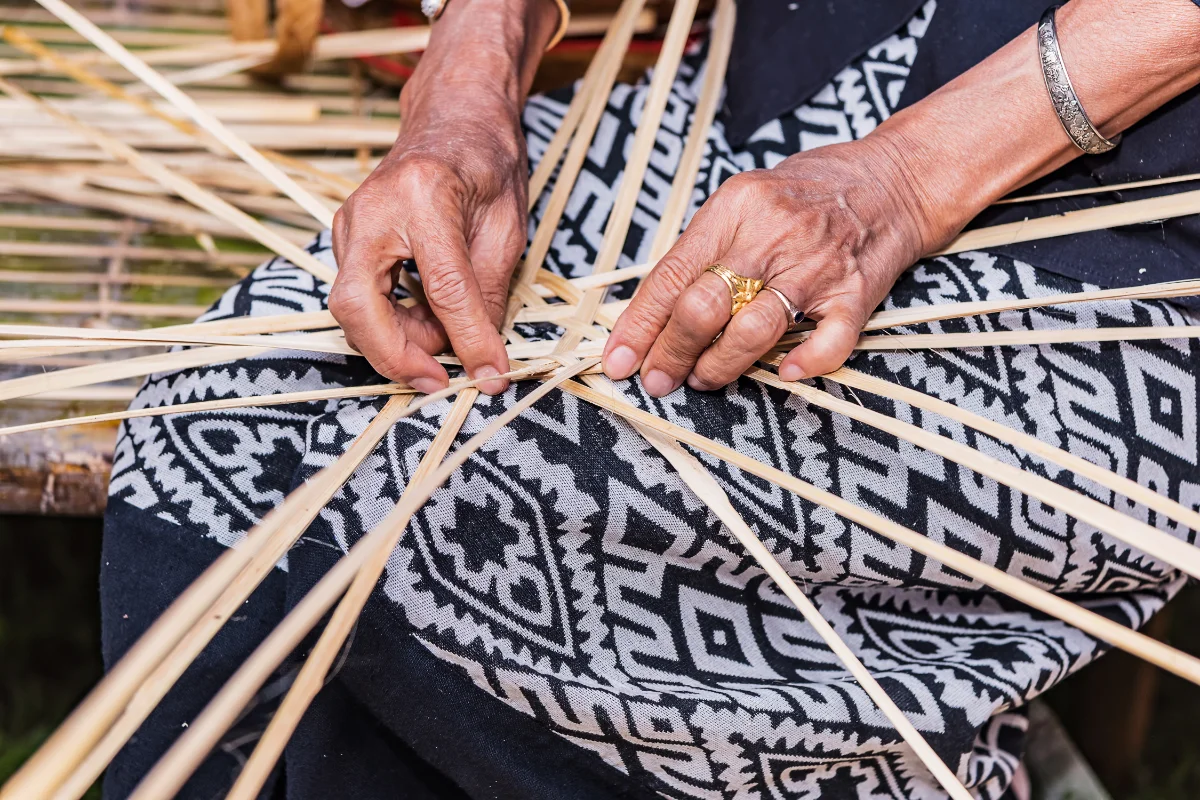
Tools Required for Bamboo Art
Creating art and crafts from bamboo necessitates a set of specialized tools. These may include cutting implements, carving tools, brushes, and specialized adhesives. The use of these tools varies depending on the specific craft, be it carving sculpture, painting, or weaving.
Step-by-Step Process of Making Bamboo Art
The creation process for bamboo art differs according to the type of craft. For bamboo painting, artists start with the selection of bamboo as the canvas, followed by intricate brushwork to depict the subject. In contrast, bamboo weaving involves the meticulous interlacing of bamboo strips to form intricate patterns or functional items. Sculpting bamboo requires delicate carving and shaping while crafting musical instruments involves precise hollowing and shaping of bamboo segments to create sound.
Harvesting Bamboo:
Select mature bamboo stems based on the desired size and characteristics of your art piece. Harvest bamboo during the dry season when it’s less likely to have excessive moisture.
Cleaning and Preparing Bamboo:
Remove leaves, branches, and any debris from the harvested bamboo. Cut bamboo into manageable lengths for your project, using a saw or machete. Treat the bamboo with a preservative or sealant to enhance durability and resist pests.
Splitting and Stripping:
Split bamboo into thin strips using a knife or machete. The size of the strips depends on your design. Strip away the outer layer of bamboo to reveal a smoother inner surface for a polished look.
Soaking and Flexibility:
Soak bamboo strips in water to increase flexibility. The soaking time depends on the thickness of the bamboo. This step is crucial for bending and shaping bamboo into intricate designs.
Design and Assembly:
Sketch or plan your design before assembling the bamboo strips. Arrange the strips according to your design, weaving or binding them together to create the desired structure. Use glue, wire, or twine to secure the bamboo strips in place.
Shaping and Forming:
Shape the bamboo strips using bending techniques, such as heat bending or molding. Create curves, loops, or intricate patterns by carefully manipulating the bamboo.
Drying:
Allow the assembled bamboo art to dry thoroughly. This helps the bamboo strips set in their designed shape. Drying times vary based on the size and thickness of the bamboo used.
Sanding and Smoothing:
Once dry, sand the bamboo surface to smooth out any rough edges or imperfections. Use fine-grit sandpaper to achieve a polished finish.
Finishing Touches:
Apply finishes or coatings to protect the bamboo and enhance its appearance. Consider using natural oils, varnish, or lacquer to add shine and durability.
Preservation:
Depending on your design, you may want to treat the bamboo art with a preservative to prevent pests and decay.
Display or Install:
Display your finished bamboo art piece in a suitable location or install it as intended.
Throughout this process, creativity and innovation play key roles. Experiment with different weaving patterns, bending techniques, and finishes to create unique and personalized bamboo art pieces that showcase the beauty and versatility of this remarkable material.
Importance of Sustainability in Bamboo Art Creation
One of the fundamental aspects of creating bamboo art and craft is the emphasis on sustainability. Artists and craftsmen often source bamboo from renewable forests, ensuring that their creative endeavors do not harm the environment. Sustainability is a core value that intertwines with the art form itself, promoting eco-friendly practices.
Uses of Bamboo Art and Craft

Decorative Purposes:
Bamboo art serves as a captivating decor element in various settings. Paintings, sculptures, and woven bamboo designs adorn homes and public spaces, adding a touch of natural elegance to the surroundings.
Functional Items:
Bamboo’s versatility extends to crafting functional items. From baskets to furniture, the durability and strength of bamboo make it an ideal material for creating everyday objects that marry utility with beauty.
Cultural Significance in Different Parts of the World
In diverse cultures, bamboo art and craft hold significant cultural symbolism. From the bamboo-centric paintings in East Asia to the intricate weavings in South America, each creation reflects the cultural essence and traditions of the region, often weaving stories and beliefs into the craft.
Benefits of Bamboo Art and Craft
Environmentally Friendly Nature of Bamboo
Bamboo, being a sustainable and fast-growing resource, contributes significantly to eco-friendly artistic endeavors. Its rapid growth and renewability make it an ideal material for those seeking to create art while minimizing environmental impact.
Long-lasting and Durable Creations
The inherent strength of bamboo ensures longevity in artistic creations. From paintings to sculptures and furniture, the durability of bamboo-made items extends their lifespan, offering both artistic beauty and practical use for an extended period.
Promoting Traditional Craftsmanship
Bamboo art and craft also act as a torchbearer for traditional craftsmanship. By employing age-old techniques and celebrating cultural practices, artisans pass down their skills and preserve cultural heritage through the creation of bamboo art.
Innovation and Modern Design:
Bamboo artistry is not confined to traditional forms. Many contemporary artists experiment with bamboo, pushing the boundaries of design and creating innovative, modern pieces that blend tradition with a fresh, artistic perspective.
Promotion of Biodiversity:
Bamboo forests support diverse ecosystems and contribute to biodiversity. By using bamboo in art and craft, artists indirectly contribute to the conservation of these ecosystems.
Economic Opportunities:
The production and sale of bamboo art and craft items can create economic opportunities for artisans and communities. This can contribute to local economies and provide livelihoods for skilled craftsmen.
Cultural Exchange:
Bamboo art serves as a form of cultural expression that can be shared and appreciated globally. It facilitates cultural exchange and understanding as artists draw inspiration from their cultural roots or explore cross-cultural themes.
Functional and Aesthetic Appeal:
Bamboo art and craft items are not only visually appealing but also functional. From furniture to utensils, bamboo items serve practical purposes while adding an aesthetic touch to living spaces.
Educational Value:
Bamboo arts and crafts offer educational value by showcasing the unique properties of bamboo and the skills required for its manipulation. This can raise awareness about sustainable materials and traditional craftsmanship.
Wellness and Connection to Nature:
The use of natural materials like bamboo in art can create a sense of connection to nature. This connection contributes to a sense of well-being and aligns with the growing appreciation for biophilic design.
Challenges and Future of Bamboo Art and Craft
Despite the many benefits of bamboo art and craft, some challenges and considerations shape the future of this creative domain. Understanding and addressing these challenges is crucial for the sustainable growth and development of bamboo artistry. Here are some key challenges and the potential future directions for bamboo art and craft:
Challenges:
Perception and Stereotypes:
Overcoming stereotypes associated with bamboo as a “primitive” or “traditional” material and highlighting its versatility and contemporary relevance.
Market Recognition:
Gaining wider recognition in mainstream art markets and overcoming the challenge of being perceived as niche or exotic.
Preservation of Traditional Techniques:
Preserving and passing down traditional bamboo crafting techniques in the face of modernization and changing skill demographics.
Sustainability Concerns:
Ensuring sustainable harvesting and production practices to prevent overexploitation of bamboo resources and addressing concerns related to monoculture.
Educational Initiatives:
Promoting educational initiatives to enhance awareness about the cultural and environmental significance of bamboo, fostering appreciation for bamboo art.
Artisan Empowerment:
Addressing socio-economic issues by providing fair compensation to artisans and ensuring their empowerment in the value chain.
Innovative Design and Technology:
Encouraging innovation in design and the incorporation of technology to attract a wider audience and create contemporary, cutting-edge bamboo art.
Global Collaboration:
Fostering international collaborations and exchanges to bring together diverse perspectives, techniques, and cultural influences in bamboo artistry.
Future Directions:

Innovation and Technology:
Embracing innovative technologies in the crafting process, such as 3D printing and digital design tools, to push the boundaries of bamboo art.
Sustainable Practices:
Promoting sustainable and eco-friendly practices, including the use of non-toxic finishes, recycled bamboo, and adherence to responsible sourcing.
Cultural Exchange Programs:
Facilitating cultural exchange programs to encourage cross-cultural pollination of ideas and techniques, enriching the diversity of bamboo art.
Education and Awareness:
Strengthening educational programs to raise awareness about the cultural and environmental value of bamboo, inspiring future generations of bamboo artisans.
Market Access and Promotion:
Improving market access for bamboo artists through strategic partnerships, exhibitions, and marketing efforts to increase visibility and demand.
Artisan Cooperatives:
Establishing artisan cooperatives and collaborative networks to empower bamboo craftsmen, share knowledge, and collectively address challenges.
Integration in Contemporary Design:
Further integrating bamboo into contemporary design trends, interior decoration, and architecture to enhance its relevance and appeal in modern settings.
Policy Advocacy:
Advocating for supportive policies at local and global levels that encourage sustainable bamboo cultivation, fair trade practices, and the growth of bamboo art and craft industries.
Conclusion:
In the realm of art and craft, bamboo stands as an extraordinary medium, offering a harmonious blend of beauty, sustainability, and cultural richness. From the delicate strokes of bamboo paintings to the sturdy yet elegant bamboo sculptures, this eco-friendly material continues to captivate artists and enthusiasts globally.
With its rich cultural significance and versatility, bamboo serves as a bridge between tradition and innovation. The challenges of sustainability and sourcing quality bamboo are being met with creative solutions, promising a future where bamboo art and craft thrive even more vibrantly.

